
Gustave Courbet
Le Bord de mer à Palavas (The Sea at Palavas), 1854
Oil on canvas, 38 x 46.2 cm
Musée Fabre, Montpellier Agglomération
© Musée Fabre, Montpellier Agglomération / Frédéric Jaulmes
Gustave Courbet at Fondation Beyeler
Gustave Courbet exhibition at Fondation Beyeler Featuring self-portraits, representations of women and pictures of grottos and seascapes, the exhibition highlights Courbet’s innovative use of colour and his strategy of ambiguity. 7 September 2014 – 18 January 2015.]]>
Source: Fondation Beyeler
The Fondation Beyeler devotes many of its exhibitions to artists whose oeuvre had a determining influence on the development of modern painting. One such key figure in art history is Gustave Courbet, who was born in Ornans near Besançon in the French Jura in 1819 and who died in La Tour-de-Peilz in Switzerland in 1877.
It is 16 years since Courbet’s work was last presented in Switzerland. The exhibition at the Fondation Beyeler, which includes 50 to 60 works, concentrates on his role as the first avant-garde painter. With his provocative canvases and his emphasis on his individuality as an artist, Courbet developed into a precursor of Modernism who broke with the conventions of traditional academic training.
Courbet’s famous painting “L’origine du mondeis” at the heart of the exhibition. This is its first public presentation anywhere in Europe other than France. Dating from 1866, the painting is the unknown masterpiece of the 19th century, a work which few saw at the time but which everyone talked about and which retains its provocativeness even today.
Depicting the springs, caves, steep limestone cliffs and thick forests found in the Jura around Ornans where he was born, Courbet’s landscapes are often combined with representations of the female nude. Human beings, sexuality and untouched nature are united in a fascinating equilibrium. Other canvases centre on the impenetrable darkness of his Jurassian mountain caves, showing him to have been a master of suggestion, a true painter of the invisible. Courbet was an artist who established new pictorial ideas.
The room entitled “Tracks in the Snow”, where Courbet’s snowscapes are displayed, shows visitors how Courbet, through his painting, transformed colour into an object. Pastose and expressive, yet of a dynamic lightness, the colour white becomes snow in those works, seeming to create its own reality.
Related content
Gustave Courbet at the Metropolitan Museum (exhibition, 2008)
Follow us on:


